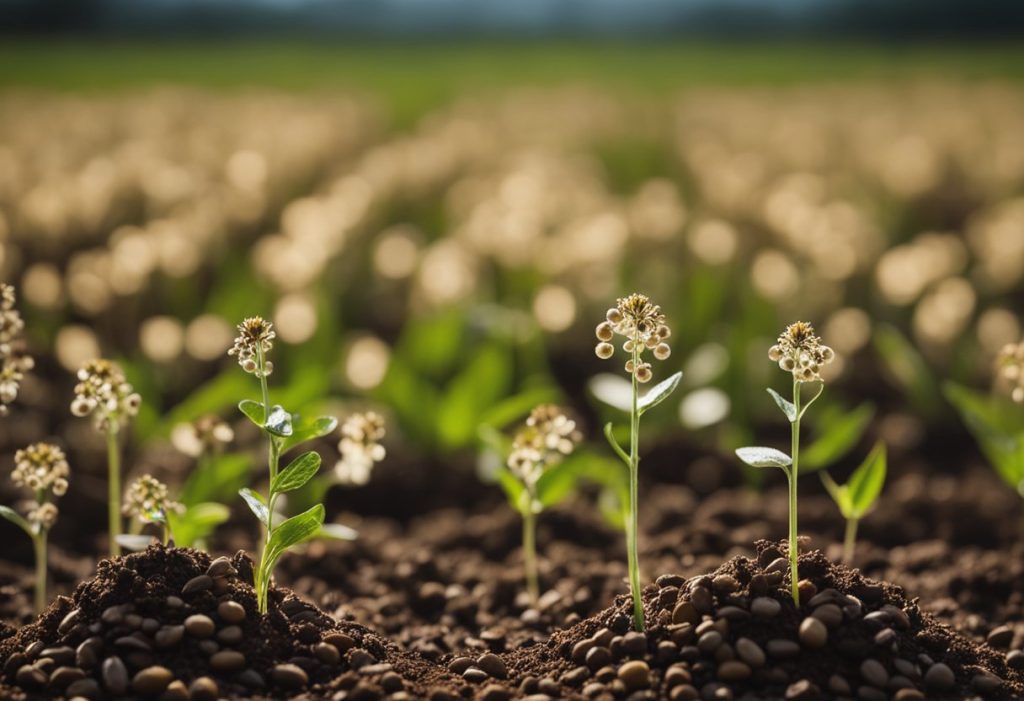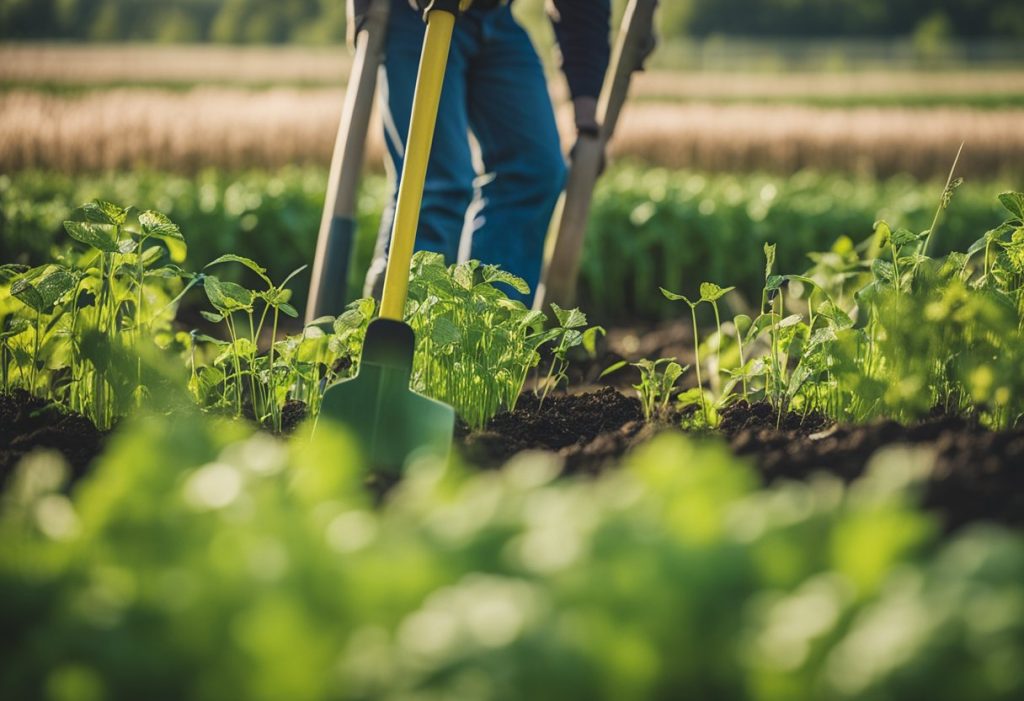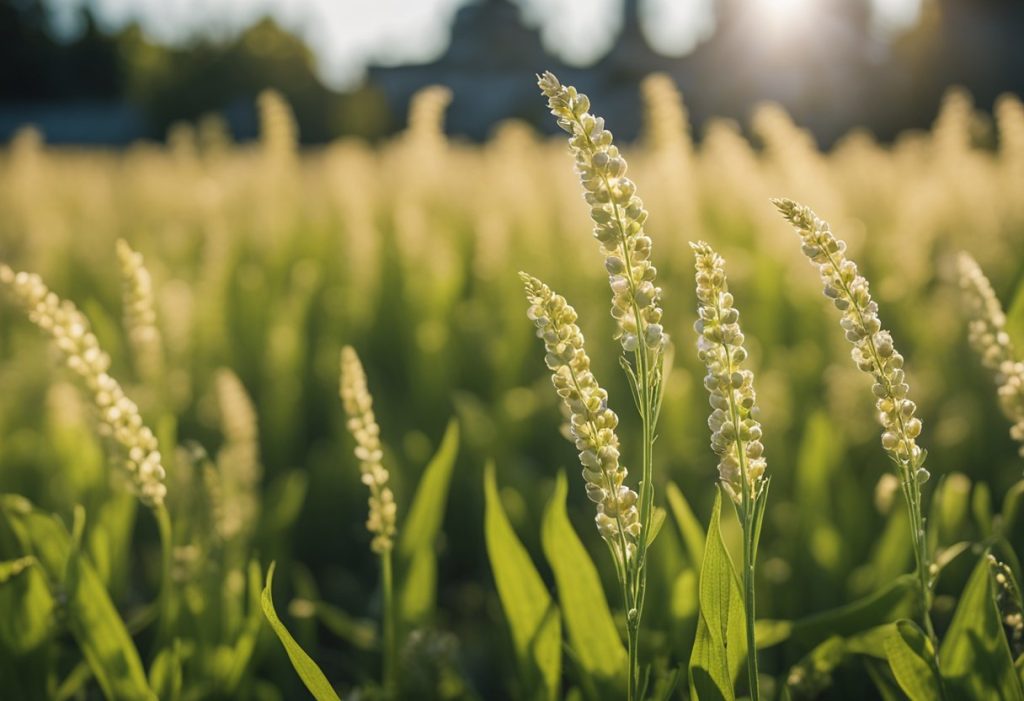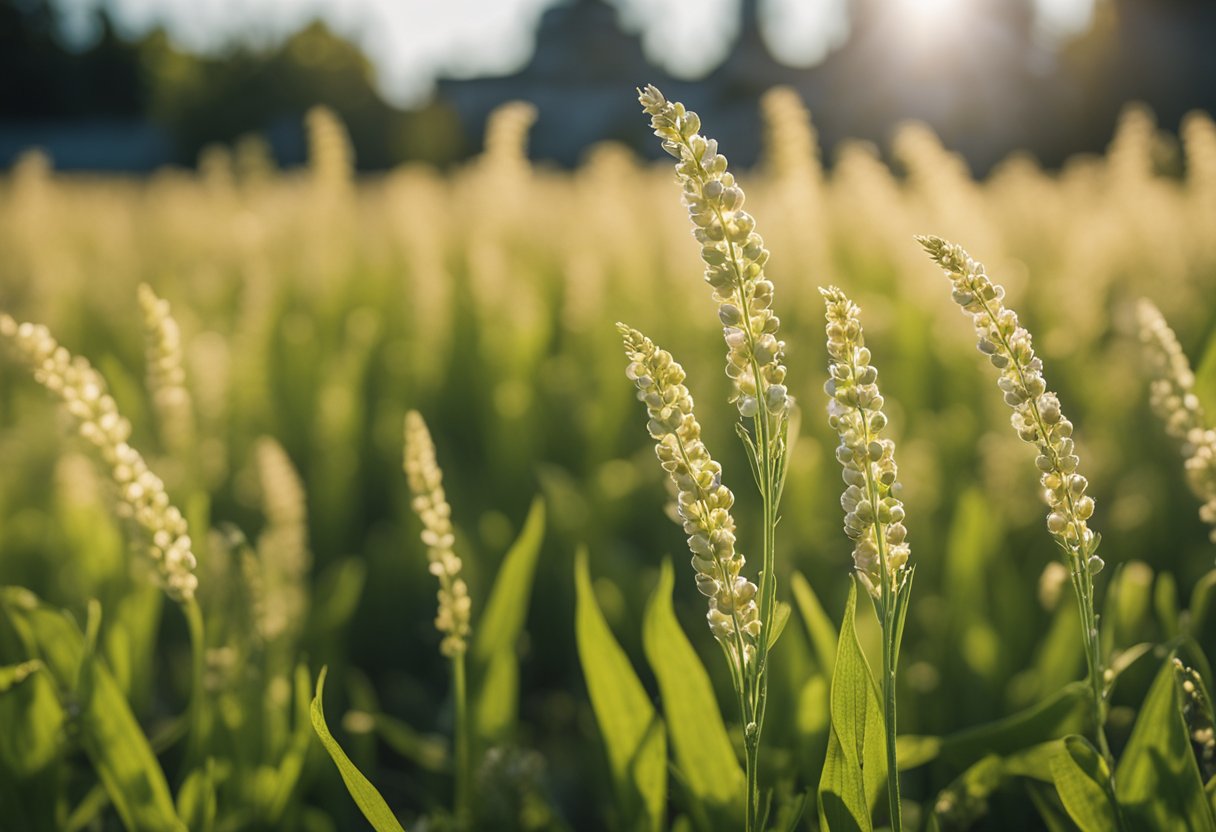Cover crop seeds are becoming an essential component in sustainable agriculture across Canada. As a gardener or farmer, you might be aware of the benefits that cover crops can offer, such as soil improvement, weed suppression, and increased biodiversity. In this article, we will delve into the world of cover crop seeds and how they can revolutionize your agricultural practices in Canada.

Understanding different types of cover crop seeds is crucial for choosing the right ones for your specific needs. Some of the most popular cover crops in Canada include grasses, legumes, and certain flower varieties, each providing their own unique set of benefits. As you explore the various options, it’s essential to consider the specific purpose and use of cover crops in your farming or gardening practices.
Managing your cover crops effectively is another fundamental aspect of successful implementation. Seeding methods and care greatly impact the benefits you can reap from these valuable plants. Taking the time to learn proper management tools and techniques will ensure the health and vitality of your cover crops, ultimately benefiting your soil, production, and overall farm profitability.
Key Takeaways
- Cover crop seeds can enhance soil health, suppress weeds, and support biodiversity in Canadian agriculture.
- Grasses, legumes, and certain flower varieties are popular choices for Canadian cover crops, each offering unique benefits.
- Proper seeding and management of cover crops are crucial in maximizing their advantages for your farm or garden.
Understanding Cover Crop Seeds
Cover crop seeds offer a variety of benefits in sustainable agriculture, such as improving soil quality, preventing erosion, and controlling pests. As you dive into the world of cover crop seeds in Canada, it’s essential to consider the species, quality, and seed suppliers while making your choice.
Firstly, let’s discuss the various species of cover crops you can choose from. There are grasses, such as rye, winter wheat, oats, barley, and sorghum, that help protect the soil from erosion and add organic matter1. Additionally, legume cover crops, like clovers and peas, can fix nitrogen from the atmosphere, supplying nitrogen to the subsequent crop1. It’s crucial to select a cover crop that aligns with your farming goals and benefits the local environment.
Quality is another critical aspect to consider when selecting cover crop seeds. High-quality seeds have higher germination rates, ensuring a successful establishment of the cover crop. You should also consider how the seeds have been stored, as they may lose their viability if not properly maintained. Opting for seeds that are certified and treated for possible pathogens will contribute to a healthier crop.
While exploring seed suppliers, look for reputable companies that specialize in providing cover crop seeds in your region. A reliable supplier2 should be knowledgeable about the product, offer a wide range of species, and provide guidance on planting and maintenance. Reach out to other farmers or research online to find credible suppliers in your area.
When choosing cover crop seeds, it’s important to consider factors like the climate, soil type, and compatibility with your existing crops. Each species may have specific requirements regarding light, moisture, and fertility that need to be met for optimal growth1. You should also be aware of any sensitivity to herbicide residues from other crops in the rotation3.
Overall, spending time researching and selecting the right cover crop seeds for your Canadian farm will lead to a successful and thriving crop that brings numerous benefits to your soil and future harvests. Remember to consider species, quality, and seed suppliers, and consult with experts when necessary, to ensure a bountiful crop.
Types of Cover Crops
Legumes Cover Crops
Legumes cover crops are an excellent choice for enriching your soil with nitrogen. These plants have the ability to fix nitrogen from the air and release it into the soil. Some popular legumes cover crops in Canada include red clover, white clover, hairy vetch, sweet clover, and alfalfa.
Red clover is a fantastic option if you want to improve soil structure and increase organic matter. It is also a great choice for suppressing weeds. White clover, on the other hand, helps break up soil compaction and has a low growth habit making it suitable for intercropping.
Grasses Cover Crops
Grasses are another type of cover crop that you can use to protect your soil from erosion and support soil health. In Canada, commonly used grasses include rye, winter wheat, oats, barley, sorghum, ryegrass, corn, pearl millet, and Japanese millet.
Barley is particularly beneficial for erosion-prone areas due to its vigorous growth and powerful root system. Rye and wheat, on the other hand, are popular choices for improving soil structure and suppressing weeds.
Brassicas Cover Crops
Brassicas are a diverse group of cover crops that provide various benefits to your soil and crop rotations. Some popular brassica cover crops in Canada are radish, oilseed radish, turnip, kale, and three types of mustard: brown mustard, oriental mustard, and white mustard.
Radishes, like oilseed radishes, are excellent for breaking up soil compaction and improving water infiltration. Turnip and kale are good choices if you’re looking for cover crops that can suppress weeds and also provide some valuable biomass. Mustards are known to help in reducing soil-borne pests and improving nutrient cycling.
By choosing the right cover crop for your needs, you’ll be well on your way to establishing a healthy, productive soil ecosystem that supports your crops and promotes sustainable farming practices.
Purpose and Use of Cover Crops
Cover crops offer numerous benefits to farmers and the environment. In this section, we will discuss some of the primary uses of cover crops, including grazing and livestock feed, soil and environmental benefits, and weed and pest control.
Grazing and Livestock Feed
Cover crops, such as forage rape and fodder rape, can provide an excellent source of feed for your livestock. Incorporating cover crops into your pasture rotation allows your animals to graze on nutrient-rich plants, improving their overall health and productivity. This approach also helps to optimize nutrient cycling within your farm, benefiting your soil and future crops.
Soil and Environmental Benefits
A key component of sustainable agriculture, cover crops help to:
- Improve soil health by adding organic matter and nutrients, such as nitrogen from legume cover crops
- Reduce soil erosion and compaction
- Increase water infiltration and retention
- Mitigate the effects of drought or heavy rainfall
These benefits work together to create a more resilient and productive agricultural system while promoting environmental stewardship.
Weed and Pest Control
Integrating cover crops into your farming practices can aid in weed and pest management. When used as a green manure, cover crops smother weeds, preventing their growth and spread. Additionally, some cover crops have been found to suppress nematodes, weeds, and other pests, reducing the need for chemical treatments.
To make the most of your cover crop choices, consider factors such as growth habits, overwintering capabilities, establishment methods, and sensitivity to herbicides. Careful selection and management of cover crops will enable you to maximize the benefits they bring to your farm – improving soil health, supporting livestock, and promoting overall sustainability.
Seeding Your Cover Crops

Choosing the Right Seeding Rate
Selecting the proper seeding rate is key to successful cover crop establishment. To calculate the ideal seeding rate, consider your goals, such as soil improvement, weed suppression, or moisture management. Use a cover crop decision tool to help you identify the best cover crop for your needs, based on factors like location, soil type and crop rotation.
Here are a few tips to help you choose the right seeding rate:
- For high biomass cover crops, such as those meant for weed suppression, use a higher seeding rate.
- If you’re planting a mixture of cover crops, adjust seeding rates to account for the combined effect of the different species.
- Make sure to account for seed size and germination rates when determining your seeding rate.
Timing and Depth of Seeding
Proper timing and seeding depth are crucial factors for successful cover crop establishment. To ensure good germination and growth, follow these guidelines:
- Plant the cover crop as soon as possible after your main crop harvest to optimize growing conditions.
- Make sure soil moisture and temperature are within the optimal range for the chosen cover crop species.
- Shallow seeding (0.5 to 1 inch deep) is generally preferred, especially for small-seeded crops like clover or radish; larger-seeded species, such as cereal rye or peas, can be seeded slightly deeper (1 to 2 inches).
- Broadcasting seeds is also an option, particularly when seeding into standing crops. This approach can be done easily with a drone seeding cover crops.
Remember, it’s crucial to monitor your cover crops’ growth and adjust your management practices to ensure they meet your intended goals. By carefully selecting the seeding rate, timing, and depth, your cover crop will thrive and help enhance your soil’s health and productivity.
Cover Crop Management Tools

As a gardener or farmer in Canada, it’s essential to take advantage of available resources to improve your crop yields and promote eco-friendly practices. One such resource is the Cover Crop Decision Tool designed for growers in Eastern Canada. This web-based tool will help you identify the cover crop best suited for your needs, depending on location, soil type, cropping system, and desired goals.
Cover crops can play a significant role in enhancing soil biodiversity, reducing erosion, and retaining moisture. A popular choice among Canadian growers looking to improve soil structure and fertility is the eco-till radish. Not only do these radishes break through compacted soil layers, but they also help suppress weeds and increase crop yields.
When planning your cover crop strategy, consider the following factors:
- Diversity: Integrating a variety of cover crops into your rotation will improve soil health and provide a better environment for beneficial organisms.
- Timing: Planting cover crops at the right time is essential to ensure they can establish well and provide maximum benefits.
- Termination: Proper termination of cover crops is crucial to prevent them from becoming a weed issue in the next crop and to capture the benefits of their growth effectively.
Here are some additional tips for successful cover crop management:
- Establishment: Sow cover crop seeds at the optimal depth and rate for their species, considering site and weather conditions.
- Selection: A diverse array of cover crops is essential for maximum benefits; choose cover crops suited to your region and soil type.
- Integration: Assess how cover crops can be incorporated into your existing crop rotation to optimize their benefits while minimizing potential issues.
By effectively using cover crop management tools and strategies like the Cover Crop Decision Tool, eco-till radishes, and diverse crop rotations, you’ll be well on your way to a more sustainable and productive agricultural operation. Remember, planning and careful decision-making are vital to maximizing the benefits cover crops can bring to your soil and crops.
Frequently Asked Questions

What are common cover crop options in Canada?
Canada has a variety of cover crop options suitable for different regions and purposes. Some common choices include winter rye, hairy vetch, clover, radish, and winter triticale. These crops can be successful in improving soil quality, suppressing weeds, and providing nutrient-rich organic matter to your garden.
Where can I find bulk cover crop seeds?
Bulk cover crop seeds can be purchased from various local and regional suppliers, or online vendors. One option is to visit a company like Speare Seeds, which specializes in providing high-quality grass, forage, corn, and organic seeds for your cover cropping needs. They offer a wide selection as well as knowledgeable staff to help guide you through your purchase.
Which cover crops are best for Alberta gardens?
When choosing cover crops for Alberta gardens, consider factors such as hardiness, growth habit, and soil nutrient needs. For instance, winter rye and winter triticale can tolerate colder temperatures and have great winter survival rates. Cover Crops Canada is a helpful resource for understanding the benefits and best uses of cover cropping in Western Canada’s diverse climates and growing conditions.
How do I choose the right cover crop for my garden?
Begin by identifying your garden’s specific needs, such as soil improvement, weed suppression, or nitrogen fixation. Next, consider the timing of planting and termination, as well as the crop’s compatibility with your main crops. Look at resources like the Ontario Ministry of Agriculture, Food and Rural Affairs for information on suitable cover crops and how to effectively incorporate them into your garden system.
What cover crop options aid in pollinator support?
To support pollinators, opt for flowering cover crops that provide nectar and pollen resources throughout the season. Choices like clover, phacelia, and buckwheat not only benefit your soil but also attract beneficial insects, promoting a more biodiverse ecosystem in your garden.
What are the best cover crops for no-till gardens?
In no-till gardens, it’s essential to choose cover crops that are easy to manage and terminate without the need for tillage. Some excellent options include crimson clover, hairy vetch, and daikon radish. These crops break down quickly, improving soil structure and fertility while not negatively impacting your main crops. Plan your cover cropping schedule and termination methods carefully to ensure minimal soil disturbance and maximum benefits in your no-till garden.
